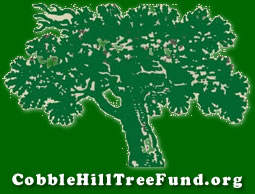TREE CARE
CARING FOR STREET TREES
A Cobble Hill Tree Fund member passed on the note and information below, sent out by our Boerum Hill neighbor, Margaret Cusack, of the Hoyt Street Association. It contains very useful reminders and important information regarding care of our street street trees during hot weather. — CHTF
With the return of Hot weather, many of the street trees can become stressed because they are not watered regularly. Please read the info below (provided by the NYC Dept of Parks & Recreation) and take an interest in the street tree nearest your home. (You might even consider adopting more than one tree.) Keeping containers of water near your front door will remind you to take care of your tree. Thanks.
—Margaret Cusack, Hoyt Street Association
GUIDELINES:
[ ] Water each young tree 15-20 gallons once a week between May and October (that’s 3-4 large buckets).
[ ] Using a hand cultivator, loosen the top 2-3 inches of soil to alleviate compaction and help the water and air reach the roots.
[ ] Water slowly so the water penetrates the soil and does not run off of the surface.
[ ] Water at the soil level, not the leaves of shrubs and groundcovers.
[ ] If it rains 1 inch or more in a week's time period, you do not need to water.
Watering is the most important thing you can do for your street tree. It may also be the most difficult task to accomplish. Transporting water from the source to the tree is a challenge. Furthermore, because of compaction and pollution, urban soil is hydrophobic and difficult to penetrate. This means that you need to cultivate or loosen the soil so that the water can reach the tree's roots. There are a number of different tools and techniques available to aid your watering efforts.
SUGGESTIONS: [ ] Poke small holes at the bottom of a large trash-can. Fill it with 15-20 gallons of water and leave the trash can next to the tree overnight.
[ ] Ask building maintenance staff to water trees while they are hosing off sidewalks.
[ ] Ask street vendors and merchants to dump water from their containers (coolers with melted ice or flower buckets) into nearby tree pits at the end of the day. Make sure water with detergent or bleach is dumped into the gutter, not the tree pit.
[ ] Apply a three-inch layer of mulch, preferably shredded bark, to the tree pit. Mulch keeps the water from evaporating quickly, reduces soil compaction, and improves the soil as it breaks down. Do not pile the mulch against the trunk of the tree or shrub; water will accumulate and rot the trunk.
[ ] Prevent dogs from peeing and pooping in the tree pits.
[ ] Remove weeds and debris from the tree pits.
TREE CARE-Our recommendations
How to keep your tree healthy and happy all year round. To stay healthy and growing, street trees need people. Here are some ways you can help.
[ ] Water regularly (once or twice in the Spring, 2-3 times a week during hot, dry weather) using 6 to 8 gallons of water at a time. Buckets of water are best as they allow you to gauge the amount of water you are using. Good soaking also allow the water to reach the roots where it does the most good.
[ ] Fertilizer and lime may be helpful. Please contact the Fund for assistance on the correct amounts as over-doing it is harmful to the tree. Loosen the top 2 inches of the soil around your tree on a regular basis. This is done with a rake or a garden claw and allows air and water to reach the roots of your tree more easily.
[ ] Salt will kill trees. In winter, use cat litter, sand or commercial non-salt de-icer instead of salt on sidewalks.
[ ] Pruning Trees for proper shaping and for preventing broken, diseased or dead branches from causing decay is very important. However, healthy pruning takes some expertise which members of the Fund can provide for young trees only.
[ ] Put a tree guard around the tree to protect the tree from cars and other damage. Please contact us for more information.
[ ] Plant shallow-rooted plants such as impatiens, wax begonias, English and Baltic ivy around your established tree.
[ ] Turn and loosen the soil. Once or twice a year, turn several trowels of peat, moss, compost and dehydrated cow manure into the tree pit to create a more spongy growing medium.
[ ] Become a Citizen Tree Pruner
To obtain further information about the course registration, contact the New York City Tree Consortium.
Trees New York
51 Chambers Street, Ste 1412A
New York, 10007
212-227-1887
www.treesny.org
COBBLE HILL TREE FUND BROCHURE (printable PDF)
HELPFUL RESOURCES
OTHER IDEAS FOR TREE CARE
New York Department of Parks & Recreation — Tree Care & Maintenance
LINKS TO PARKS
Cobble Hill Park
Propect Park Alliance
LEARN MORE ABOUT TREES
New York City Department of Parks and Recreation
City Parks Foundation
Brooklyn Botanic Garden (Home page)
Brooklyn Botanic Garden, Big City, Big Trees
Trees New York
National Tree Benefit Calculator
LEARN ABOUT THE ASIAN LONG-HORNED BEETLE
NY Department of Parks & Recreation
PERMITS/FORMS
CB6 Street Tree Planting Request Form
COMPOSTING
NYC Waste Less—Composting in NYC
Food Waste Community Drop-offs
Lower East Side Ecology Center
A Cobble Hill Tree Fund member passed on the note and information below, sent out by our Boerum Hill neighbor, Margaret Cusack, of the Hoyt Street Association. It contains very useful reminders and important information regarding care of our street street trees during hot weather. — CHTF
With the return of Hot weather, many of the street trees can become stressed because they are not watered regularly. Please read the info below (provided by the NYC Dept of Parks & Recreation) and take an interest in the street tree nearest your home. (You might even consider adopting more than one tree.) Keeping containers of water near your front door will remind you to take care of your tree. Thanks.
—Margaret Cusack, Hoyt Street Association
GUIDELINES:
[ ] Water each young tree 15-20 gallons once a week between May and October (that’s 3-4 large buckets).
[ ] Using a hand cultivator, loosen the top 2-3 inches of soil to alleviate compaction and help the water and air reach the roots.
[ ] Water slowly so the water penetrates the soil and does not run off of the surface.
[ ] Water at the soil level, not the leaves of shrubs and groundcovers.
[ ] If it rains 1 inch or more in a week's time period, you do not need to water.
Watering is the most important thing you can do for your street tree. It may also be the most difficult task to accomplish. Transporting water from the source to the tree is a challenge. Furthermore, because of compaction and pollution, urban soil is hydrophobic and difficult to penetrate. This means that you need to cultivate or loosen the soil so that the water can reach the tree's roots. There are a number of different tools and techniques available to aid your watering efforts.
SUGGESTIONS: [ ] Poke small holes at the bottom of a large trash-can. Fill it with 15-20 gallons of water and leave the trash can next to the tree overnight.
[ ] Ask building maintenance staff to water trees while they are hosing off sidewalks.
[ ] Ask street vendors and merchants to dump water from their containers (coolers with melted ice or flower buckets) into nearby tree pits at the end of the day. Make sure water with detergent or bleach is dumped into the gutter, not the tree pit.
[ ] Apply a three-inch layer of mulch, preferably shredded bark, to the tree pit. Mulch keeps the water from evaporating quickly, reduces soil compaction, and improves the soil as it breaks down. Do not pile the mulch against the trunk of the tree or shrub; water will accumulate and rot the trunk.
[ ] Prevent dogs from peeing and pooping in the tree pits.
[ ] Remove weeds and debris from the tree pits.
TREE CARE-Our recommendations
How to keep your tree healthy and happy all year round. To stay healthy and growing, street trees need people. Here are some ways you can help.
[ ] Water regularly (once or twice in the Spring, 2-3 times a week during hot, dry weather) using 6 to 8 gallons of water at a time. Buckets of water are best as they allow you to gauge the amount of water you are using. Good soaking also allow the water to reach the roots where it does the most good.
[ ] Fertilizer and lime may be helpful. Please contact the Fund for assistance on the correct amounts as over-doing it is harmful to the tree. Loosen the top 2 inches of the soil around your tree on a regular basis. This is done with a rake or a garden claw and allows air and water to reach the roots of your tree more easily.
[ ] Salt will kill trees. In winter, use cat litter, sand or commercial non-salt de-icer instead of salt on sidewalks.
[ ] Pruning Trees for proper shaping and for preventing broken, diseased or dead branches from causing decay is very important. However, healthy pruning takes some expertise which members of the Fund can provide for young trees only.
[ ] Put a tree guard around the tree to protect the tree from cars and other damage. Please contact us for more information.
[ ] Plant shallow-rooted plants such as impatiens, wax begonias, English and Baltic ivy around your established tree.
[ ] Turn and loosen the soil. Once or twice a year, turn several trowels of peat, moss, compost and dehydrated cow manure into the tree pit to create a more spongy growing medium.
[ ] Become a Citizen Tree Pruner
To obtain further information about the course registration, contact the New York City Tree Consortium.
Trees New York
51 Chambers Street, Ste 1412A
New York, 10007
212-227-1887
www.treesny.org
COBBLE HILL TREE FUND BROCHURE (printable PDF)
HELPFUL RESOURCES
OTHER IDEAS FOR TREE CARE
New York Department of Parks & Recreation — Tree Care & Maintenance
LINKS TO PARKS
Cobble Hill Park
Propect Park Alliance
LEARN MORE ABOUT TREES
New York City Department of Parks and Recreation
City Parks Foundation
Brooklyn Botanic Garden (Home page)
Brooklyn Botanic Garden, Big City, Big Trees
Trees New York
National Tree Benefit Calculator
LEARN ABOUT THE ASIAN LONG-HORNED BEETLE
NY Department of Parks & Recreation
PERMITS/FORMS
CB6 Street Tree Planting Request Form
COMPOSTING
NYC Waste Less—Composting in NYC
Food Waste Community Drop-offs
Lower East Side Ecology Center


